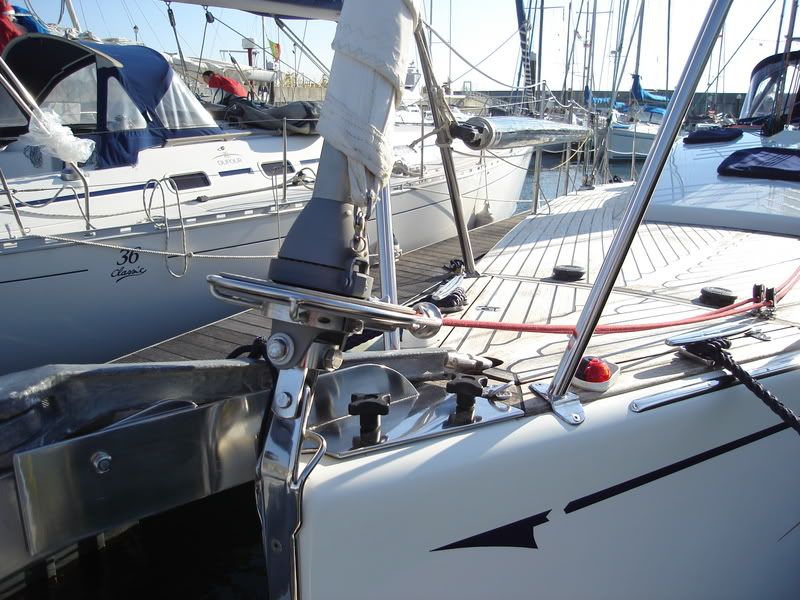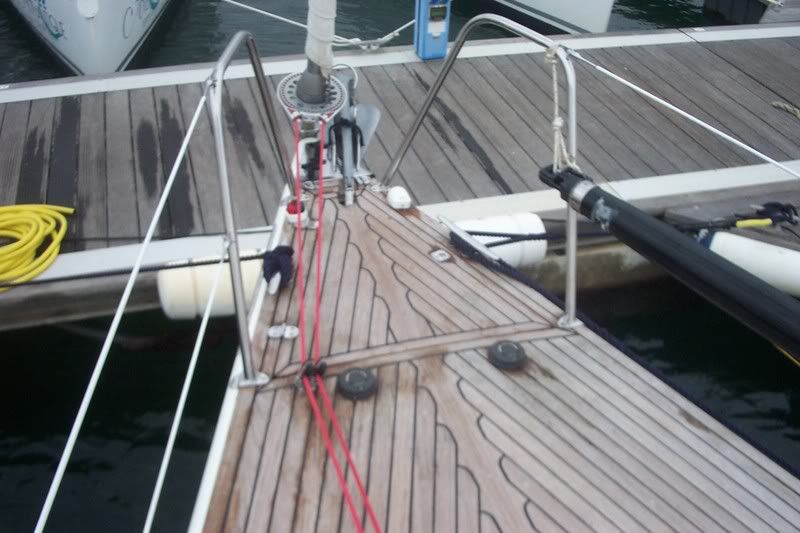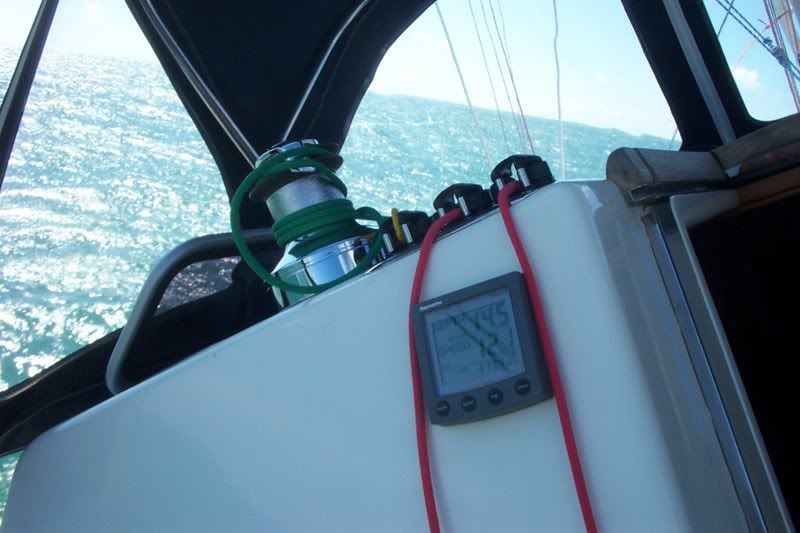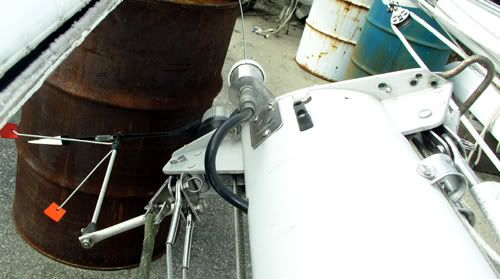Hi all. This hasn't happenned to me (yet) but I was just wondering, always wanting to have a contingency plan: If you have your genoa furled 30% or so in high winds and the furler jams so that you can neither furl nor unfurl, what do you do?

-
SailNet is a forum community dedicated to Sailing enthusiasts. Come join the discussion about sailing, modifications, classifieds, troubleshooting, repairs, reviews, maintenance, and more!
SailNet Archive
Jammed Furler
SailNet Archive
Discussion starter
87,689 posts
·
Joined 1999
- Add to quote
Hi all. This hasn't happenned to me (yet) but I was just wondering, always wanting to have a contingency plan: If you have your genoa furled 30% or so in high winds and the furler jams so that you can neither furl nor unfurl, what do you do?
4,381 posts
·
Joined 2000
Run downwidn so the main blankets the jib, untie your stopper knots and remove the sheets from the turning blocks. Then either:
1. unfurl the sail by passing a sheet in front of the forestay, counter to the direction of the furler, and then pulling a wrap off the furler, use a sheet winch if necessary. Continue until the sail is unwrapped, then dump the sail and remove.
2. If the sail won't unwrap, then pass the sheet in front of the forestay in the same direction as the furler, and manually wrap the sail around the forestay. When done, secure the furled sail with some ties. On the next calm day, straighten the mess out.
1. unfurl the sail by passing a sheet in front of the forestay, counter to the direction of the furler, and then pulling a wrap off the furler, use a sheet winch if necessary. Continue until the sail is unwrapped, then dump the sail and remove.
2. If the sail won't unwrap, then pass the sheet in front of the forestay in the same direction as the furler, and manually wrap the sail around the forestay. When done, secure the furled sail with some ties. On the next calm day, straighten the mess out.
19,468 posts
·
Joined 2005
Probably the biggest cause of a jammed furling line is letting it free run during the unfurl, especially in a breeze. This pulls the loops into the furler at a high rate of knots <g>, and the loose loops can overlap and override each other.
It's really important to keep some tension on the furling line as you pull out the headsail with the sheet. Take a turn around a winch or a cleat on the larger sails that can overpower someone holding the furling line, especially when a good breeze grabs the sail.
Prevention's worth a.....
It's really important to keep some tension on the furling line as you pull out the headsail with the sheet. Take a turn around a winch or a cleat on the larger sails that can overpower someone holding the furling line, especially when a good breeze grabs the sail.
Prevention's worth a.....
1,756 posts
·
Joined 2007
On the prevention is better that cure tack, watch the head of the sail while furling, not the foot. I've seen a spinnaker halyard vanish into the wrap with expensive results.
43,281 posts
·
Joined 2006
Also, keeping both the furling line and the headsail sheets under tension during the unfurling and furling process will help eliminate most of the jamming problems .
As for the spinnaker halyard, I generally recommend running it aft of the spreaders when it is not in use and tensioning it, to prevent it from wrapping on the roller furling headsail.
As for the spinnaker halyard, I generally recommend running it aft of the spreaders when it is not in use and tensioning it, to prevent it from wrapping on the roller furling headsail.
4,858 posts
·
Joined 2004
While attempting to remove my Genoa from the Furlex during last season's decomissioning, it was discovered that the wire halyard had wrapped itself around the furling head. This necessitated going aloft - took a while to untangle the rat's nest.
We will install sails in a couple weeks and am hoping the kinked wire will not cause any problems.
We will install sails in a couple weeks and am hoping the kinked wire will not cause any problems.
43,281 posts
·
Joined 2006
TB-
I would see about replacing the wire. Kinked wire generally loses quite a bit of its strength, and it is also more likely to "misbehave" than an unkinked halyard would.
I would see about replacing the wire. Kinked wire generally loses quite a bit of its strength, and it is also more likely to "misbehave" than an unkinked halyard would.
4,858 posts
·
Joined 2004
I'm considering replacing the rope-tailed wire halyards with all rope anyway - if the masthead sheaves would accept them.
4,647 posts
·
Joined 2005
I understand that this is one scenario that causes a lot of concern with furlers. I have a preventer installed on the forestay which is supposed to prevent the halyard from wrapping around the forestay.
TB, do you have a preventer? If not, I would think you would want to look into it before launching.
Im still learning about furlers. I go back to the days of hanked on head sails.
TB, do you have a preventer? If not, I would think you would want to look into it before launching.
Im still learning about furlers. I go back to the days of hanked on head sails.
10,850 posts
·
Joined 2006
Want to solve this problem once and for all..Get one of these...
![Image]()
Guaranteed nor jamming....
![Image]()
![Image]()

Guaranteed nor jamming....


4,647 posts
·
Joined 2005
I have heard about and seen those G.
Called a single line furler or something like that.
Too bad my boat didn't come with one. Probably a hefty bill to update at this point.
Called a single line furler or something like that.
Too bad my boat didn't come with one. Probably a hefty bill to update at this point.
4,858 posts
·
Joined 2004
sailor, I don't have a preventer on my jib halyard - can you provide a descriptive, link or photo?
10,850 posts
·
Joined 2006
TB, the genoa furler drum rotates any way you want, left or right, and all I have is a continuous loop that is cleated on the back at the cockpit, by 2 cleats.TrueBlue said:Nice piece of equipment Giu. It the furler drum ratcheted, or do you simply jamcleat the furler line at the cockpit?
Just noticed that even your spinpole is carbon fiber.
See the red ropes here..they go into the furler, along the cockpit...

This system is simple, very light and trouble free..also allows a loow foot genoa to be installed to increase performance..
Get this...I have a twin slot genoa track, (to do twin gib downwind) and it allows the furling of both sails together!!
4,858 posts
·
Joined 2004
Nice - but looks expensive as a retrofit.
12.1 knots!!! Is that all that sled can do? <G>
12.1 knots!!! Is that all that sled can do? <G>
10,850 posts
·
Joined 2006
Sailor, its a code zero check it here... click on code zero, then custom rangesailortjk1 said:I have heard about and seen those G.
Called a single line furler or something like that.
Too bad my boat didn't come with one. Probably a hefty bill to update at this point.
Its pretty cool, you can have a cruising sail the same size as a racing sail..
4,858 posts
·
Joined 2004
I was wondering how you got your genoa so low to deck in previous photos. That certainly gives you an edge.
19,468 posts
·
Joined 2005
TB - do you have (or do you have space for) a padeye just below the halyard sheave at the masthead, with the halyard running through it to the top swivel? This puts a slight out-of-line pull on the halyard and discourages halyard wrap.TrueBlue said:While attempting to remove my Genoa from the Furlex during last season's decomissioning, it was discovered that the wire halyard had wrapped itself around the furling head. This necessitated going aloft - took a while to untangle the rat's nest.
We will install sails in a couple weeks and am hoping the kinked wire will not cause any problems.
This would be easier to implement with an all rope halyard as you are considering.
10,850 posts
·
Joined 2006
Actually that was a solution to a problem..I didn't want a furler at all, but because 3 months a year my wife likes us to cruise in Southern Europe, I needed a simple system that wouldn't affect performance when we use the race sails. So this is why we had this made.
The difficult part was the bow piece and the metal insert you see going inside the furler. But everything has a solution.
The cost of these is slightly higher than a normal furler, but its worth it.. just...a big just...needs washing every now and then, since the bearings are torlon.
The difficult part was the bow piece and the metal insert you see going inside the furler. But everything has a solution.
The cost of these is slightly higher than a normal furler, but its worth it.. just...a big just...needs washing every now and then, since the bearings are torlon.
4,858 posts
·
Joined 2004
I just checked the photos of my masthead, last time it was unstepped. I don't believe there's a pad eye - unfortuantely, not visible in these shots.
![Image]()
![Image]()
I'll check to see if I have a fore view.


I'll check to see if I have a fore view.
4,647 posts
·
Joined 2005
Here is the link to Profurl which shows the wrapstop/preventer.
Not a real good picture.
http://www.profurl.com/us/produits/basic.htm
Not a real good picture.
http://www.profurl.com/us/produits/basic.htm
43,281 posts
·
Joined 2006
TB-
Unfortunately, wire halyard sheaves are often too narrow and the wrong shape to accept rope halyards. Wire halyard sheaves usually have a v-shaped groove rather than the u-shaped groove needed by rope halyards.
So if you want to replace the wire-to-rope with all rope, replacing the masthead sheaves is usually necessary.
Unfortunately, wire halyard sheaves are often too narrow and the wrong shape to accept rope halyards. Wire halyard sheaves usually have a v-shaped groove rather than the u-shaped groove needed by rope halyards.
So if you want to replace the wire-to-rope with all rope, replacing the masthead sheaves is usually necessary.
935 posts
·
Joined 2001
TB - Although the second one is hard to make out in your picture I believe you already have 2 (for your 2 possible forsails) of what I thought was considered 'jib halyard wrap preventers'. Simply those approx 2 inch long U shaped tunnels (over sized fairleads) bolted to the top front of the mast above the upper furler bearing that the halyards pass through to keep the jib halyards from flopping around during a poor furl. I've never seen or heard of ProFurls (I assume proprietary) method of keeping things in line before. To me they look a bit micky mouse (and expensive) - but maybe they are more foolproof 
As for replacing the meat hook makers... that's the first thing I did last spring. I was amazed at Nauticat's antiquated wire on my '99. Although using the existing sheaves may not be the absolute 'right' thing to do.... I'm not worried really about it. They work fine, it's been a year, I'll watch for extra wear, and when I go up there this year I'll look for halyard dust as a possible wearing problem indicator.
As for replacing the meat hook makers... that's the first thing I did last spring. I was amazed at Nauticat's antiquated wire on my '99. Although using the existing sheaves may not be the absolute 'right' thing to do.... I'm not worried really about it. They work fine, it's been a year, I'll watch for extra wear, and when I go up there this year I'll look for halyard dust as a possible wearing problem indicator.
4,858 posts
·
Joined 2004
Stan,
Until Faster pointed that out earlier in this highjacked thread, I never realized what they were used for. The PO had both jib halyards outside of these wrap preventers (one halyard's actually intended for use with a spinnaker or staysail).
Consequently, when the masts were unstepped in '04 after our purchase of the boat, we didn't thread them through. It seems as though the U-brackets need to be unscrewed to do so, since the shackles will certainly not fit.
Until Faster pointed that out earlier in this highjacked thread, I never realized what they were used for. The PO had both jib halyards outside of these wrap preventers (one halyard's actually intended for use with a spinnaker or staysail).
Consequently, when the masts were unstepped in '04 after our purchase of the boat, we didn't thread them through. It seems as though the U-brackets need to be unscrewed to do so, since the shackles will certainly not fit.
1,756 posts
·
Joined 2007
That U-shaped fairlead near the mast head is essential to keep the 10 degree angle needed between the halyard and the foil to prevent wire wrap. You have to keep an eye on them with wire halyards, as the wire cuts through them. I caught mine about half way through.
-
?
-
?
-
?
-
?
-
?
-
?
-
?
-
?
-
?
-
?
-
?
-
?
-
?
-
?
-
?
-
?
-
?
-
?
-
?
-
?
- posts
- 1.7M
- members
- 180K
- Since
- 1990
A forum community dedicated to Sailing, boating, cruising, racing & chartering. Come join the discussion about sailing, destinations, maintenance, repairs, navigation, electronics, classifieds and more
Top Contributors this Month
View All
Minnewaska
121 Replies
OntarioTheLake
72 Replies
MikeOReilly
46 Replies





